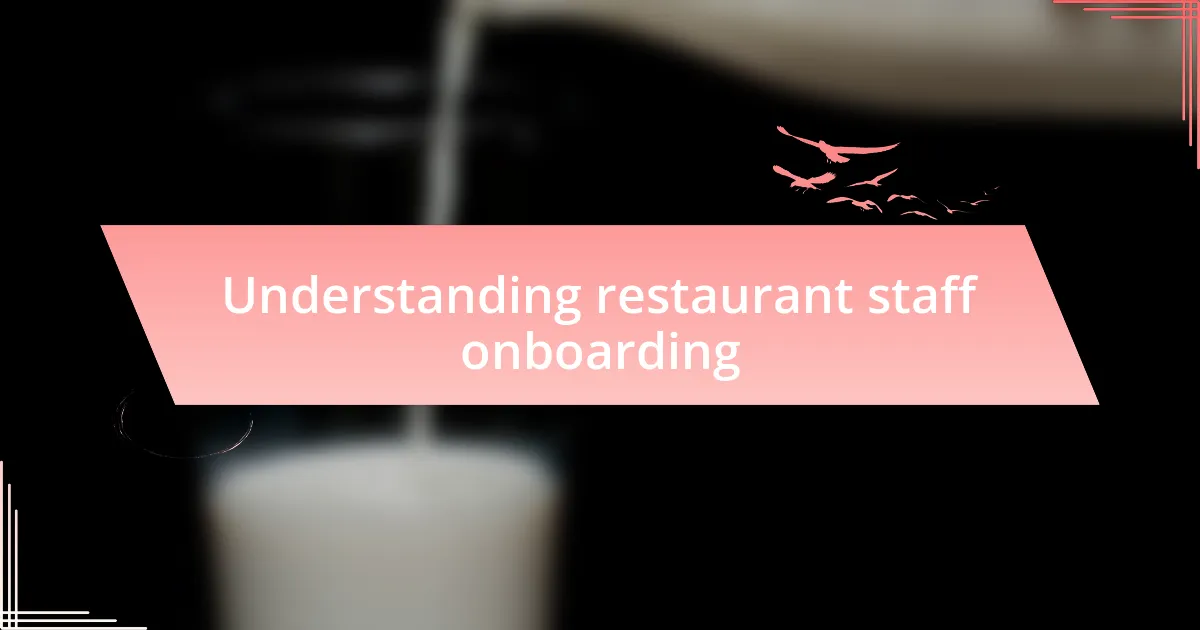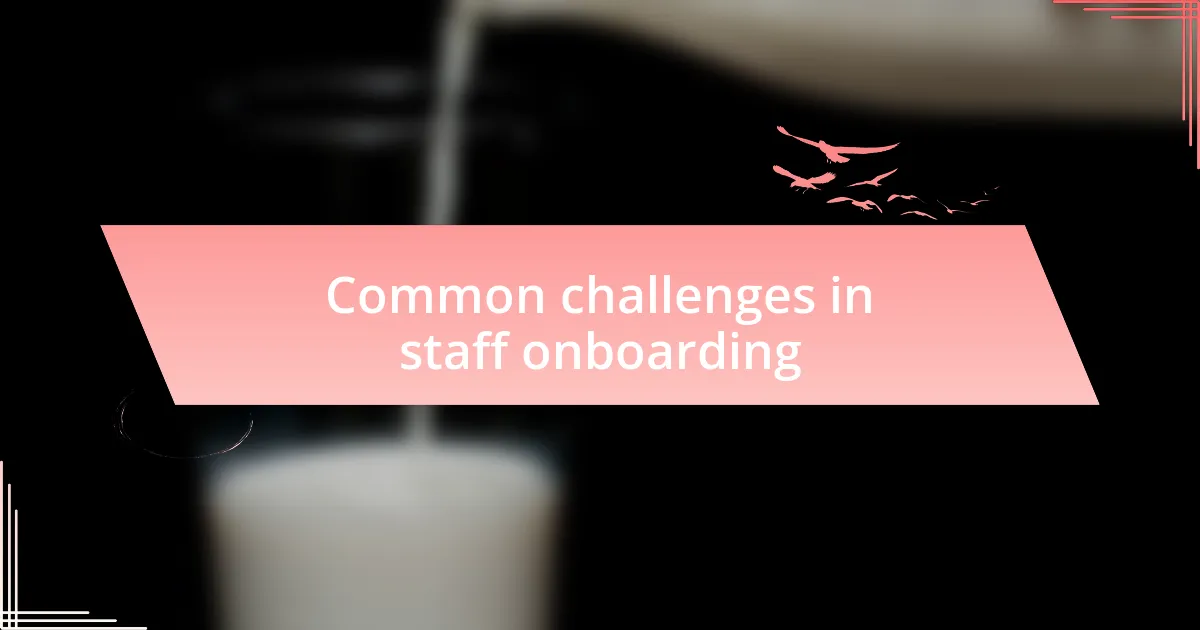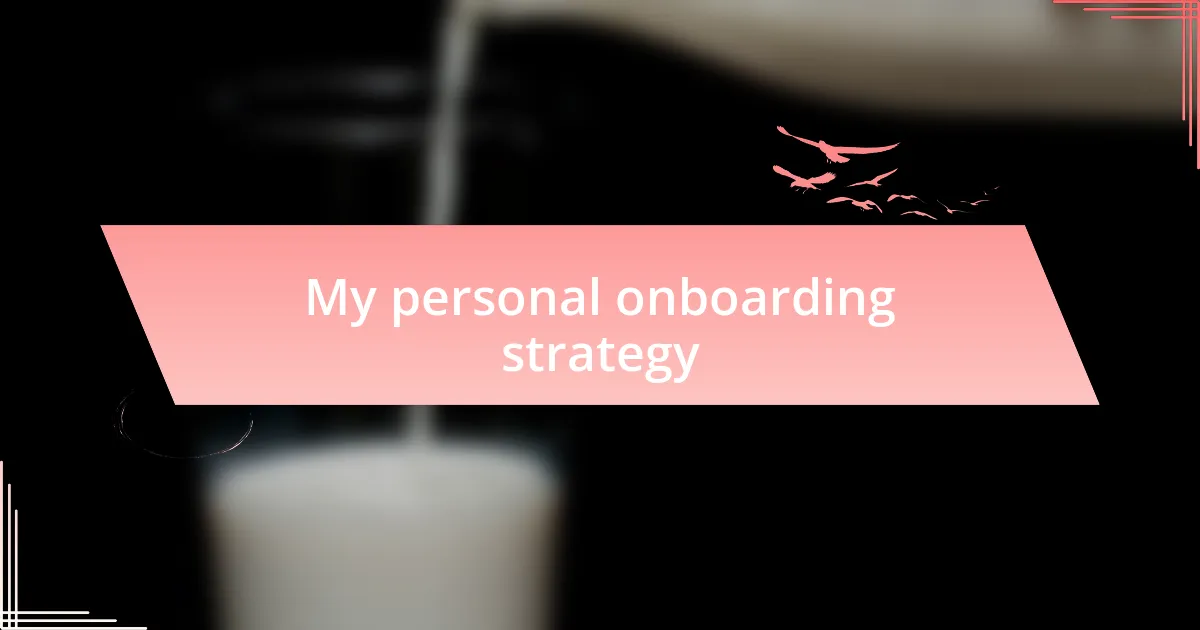Key takeaways:
- A structured onboarding process, including mentorship and storytelling, fosters employee connection and confidence from day one.
- Effective onboarding impacts employee engagement and retention, with clear expectations and support leading to higher job satisfaction.
- Common challenges include inconsistent training and lack of communication, which can hinder a new hire’s integration.
- Utilizing digital tools and personalized check-ins can significantly enhance the onboarding experience, fostering a supportive team environment.

Understanding restaurant staff onboarding
Understanding restaurant staff onboarding is crucial for creating a cohesive and efficient team. I remember my early days in the restaurant industry. Each new hire came in with excitement but also a heap of nerves. I often wondered, how could we alleviate that first-day anxiety? The answer lies in a structured onboarding process that inspires confidence from the start.
In my experience, a well-designed onboarding program goes beyond just introducing policies and procedures. It’s about fostering relationships and building a sense of belonging. I once implemented a buddy system, pairing new hires with seasoned team members. This not only eased their transition but also encouraged camaraderie. Did you know that employees are more likely to stay with a company if they feel connected in their first few weeks?
Moreover, onboarding is an opportunity to instill the restaurant’s culture and values. Reflecting on my journey, I realize the importance of storytelling during training sessions. Sharing tales of challenges and triumphs helped new staff understand their role in our collective mission. Have you considered how storytelling could transform your onboarding process? By engaging employees emotionally, we lay the groundwork for loyalty and team spirit right from the start.

Importance of effective onboarding
Effective onboarding is essential for setting the tone of a new hire’s journey in the restaurant. I recall a situation where a new server, filled with anticipation, struggled during their early shifts due to inadequate training. By not receiving proper guidance from the get-go, they felt overwhelmed and disconnected. This experience underscores how a structured onboarding program can significantly impact an employee’s confidence, job satisfaction, and ultimately, their decision to stay.
It’s fascinating to note that an effective onboarding process can lead to increased employee engagement and productivity. I once saw a tangible shift in a new chef’s performance after we introduced clear expectations and a thorough training timeline. Instead of floundering, they quickly became an asset to our kitchen. Why does this happen? When employees feel prepared and valued from day one, they’re more likely to invest their time and energy into their roles.
Moreover, onboarding isn’t just about skills; it’s about igniting passion. I remember a new hire who had initially been unsure about joining our team. After a welcoming onboarding experience that included sharing our restaurant’s history and values, they blossomed into one of our top performers. Have you thought about how sharing your restaurant’s story could resonate with new hires? The emotional connection built during this phase can transform a simple job into a fulfilling career.

Common challenges in staff onboarding
Staff onboarding often encounters hurdles that can hinder a smooth transition for new employees. For instance, I vividly remember a time when a lack of clear communication led to confusion about shift schedules and responsibilities. New hires were left guessing their roles, which not only caused frustration but also impacted the overall team dynamic. How can we expect employees to perform at their best if they don’t even know what’s expected of them?
Another common challenge is the variability in training approaches among staff members. During my early days in the restaurant industry, I witnessed how different trainers often delivered inconsistent information. Some would provide detailed instructions, while others merely skimmed over essential processes. This inconsistency can create an environment of uncertainty and dissatisfaction. Have you considered how a standardized training approach could result in a more cohesive team and smoother operations?
Finally, the emotional aspect of onboarding cannot be overlooked. I once had a new dishwasher who felt isolated and disengaged during their first week. Without a mentor or buddy to guide them, their confidence dwindled. It’s crucial for us to consider how we can foster connections early in the onboarding process. Can you imagine how much more smoothly things would flow if every new hire felt supported and included from day one? Creating an inviting atmosphere not only supports new employees but strengthens the entire team.

Steps to streamline the process
To streamline the onboarding process, I found that creating a comprehensive training manual was essential. In my experience, new hires often feel overwhelmed by the sheer volume of information they need to absorb. Providing them with a structured document that outlines procedures, expectations, and even FAQs clearly reduced their anxiety and helped them ramp up more quickly. Have you ever noticed how having a reference guide can significantly improve confidence levels in a new role?
Another effective step I adopted was setting up regular check-ins during the first few weeks. Early in my career, I realized that new staff members often struggled silently with their tasks. By proactively reaching out to them, I not only addressed their questions but also built rapport, which made them feel valued. Asking for feedback during those conversations also allowed me to refine the onboarding experience continuously. Have you considered how often new employees might hesitate to voice their concerns?
Finally, I began organizing team-building activities in the early days of a new hire’s journey. I remember hosting a casual lunch where existing staff could share their experiences and tips. This social interaction helped to break down barriers and foster a sense of community. When employees feel connected and supported, they not only adapt faster but also contribute positively to the restaurant atmosphere. Isn’t it amazing how a simple shared meal can lay the foundation for strong relationships?

Tools to aid onboarding
When it comes to tools that can facilitate onboarding, I’ve found that digital platforms can make a world of difference. I started using an onboarding software that successfully guided new staff through their training modules. It’s remarkable how visual aids and step-by-step instructions can turn what used to feel like an overwhelming process into an engaging experience. Have you ever tried a tool that truly transformed how you learn new material?
In addition, I’ve integrated a communication app specifically for our team. Right from day one, it allows new hires to connect with their colleagues, ask questions, and access vital resources instantly. I remember how one of my new servers felt completely at ease when she realized she could message her peers for help rather than feeling lost on the floor. How often do we miss out on creating that first line of support for newcomers?
Lastly, utilizing feedback tools has been invaluable for improving the onboarding experience. After each onboarding cycle, I would send out a simple survey to gather insights about what worked and what didn’t. One response stood out from a new kitchen staff member who appreciated the clarity of our onboarding materials but suggested including more practical cooking demonstrations. Isn’t it fascinating how easily a little feedback can spark significant improvements?

My personal onboarding strategy
To create a seamless onboarding experience, I focus on personalization. I make it a point to sit down with each new hire for a casual welcome chat, understanding their backgrounds and what excites them about joining our team. I recall a young chef who had a passion for fusion cuisine; knowing this allowed me to tailor her training towards incorporating these ideas into our menu, which energized both her and the kitchen staff.
I’ve found that pet-friendly policies foster a welcoming atmosphere that eases nerves during the first few days. One of my most cherished memories is when a new server brought her dog to the first team meeting. It broke the ice and led to laughter, ultimately transforming a formal introduction into a lively exchange. Isn’t it amazing how such simple gestures can build connections among team members?
Moreover, frequent check-ins during the first month are crucial. I schedule brief one-on-one sessions to discuss their experiences and address any challenges. There was a time when a new barista admitted she was struggling with our espresso machine. By providing one-on-one coaching, not only did she gain confidence, but she also became one of our most skilled baristas. Isn’t that the ultimate goal of effective onboarding?

Measuring onboarding success
Measuring onboarding success goes beyond just tracking hours or completion of training modules; it’s about evaluating the new hire’s confidence and integration into the team. I remember a time when I introduced a feedback loop during the onboarding process. After a new server completed her initial training, I asked her to rate her comfort level with each task. Her honest responses not only highlighted areas for improvement but also made her feel heard and valued. How often do we overlook the importance of this simple act of asking?
Another effective metric I’ve used is observing employee performance and engagement levels after their onboarding period. In one instance, a recent hire struggled for the first few weeks but, through consistent support and tailored training, she blossomed into a high-performing team member. Her transformation was evident through her enthusiasm during shifts and her proactive suggestions for improving workflow. Doesn’t it make you wonder how much potential lies waiting to be unlocked with the right support?
Lastly, I find that retention rates within the first 90 days can be a telling sign of onboarding effectiveness. I’ve experienced situations where clear goals and genuine mentorship led to a notably lower turnover rate. One new chef, under my guidance, not only felt equipped to succeed but also became an advocate for our restaurant culture. Isn’t it fascinating how purposeful onboarding can yield lasting benefits for both individuals and the business?